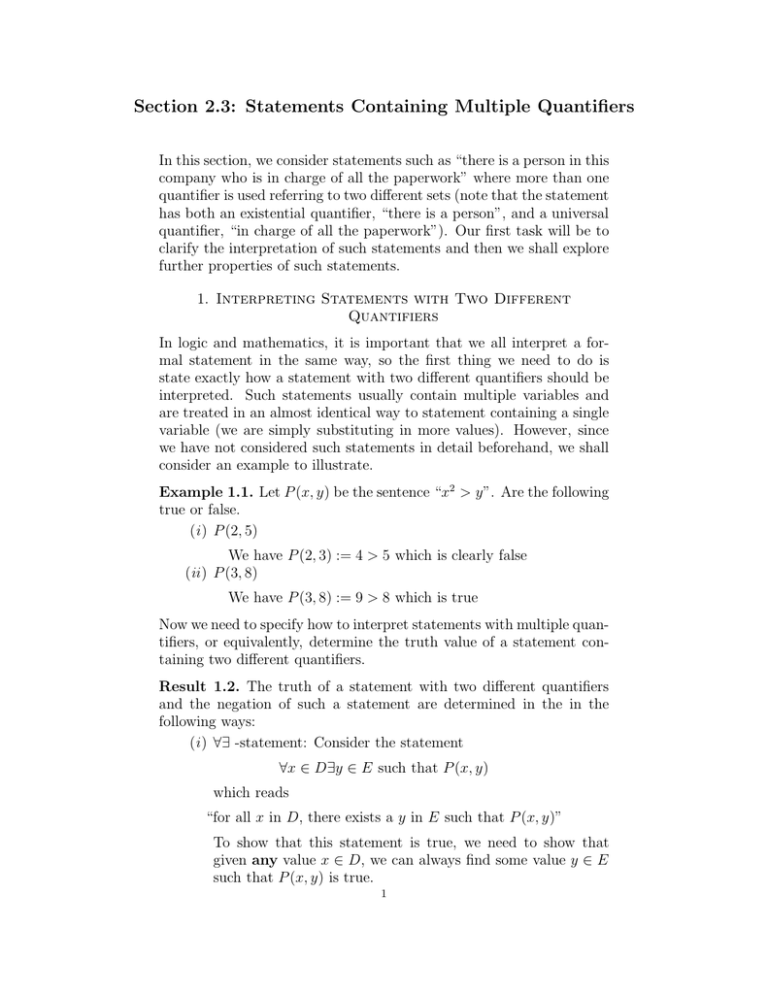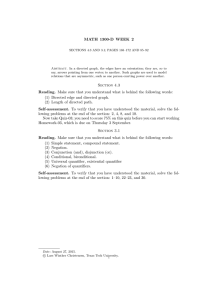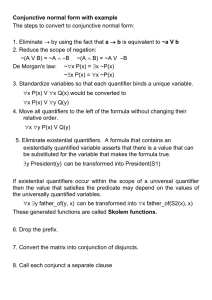Section 2.3: Statements Containing Multiple Quantifiers
advertisement

Section 2.3: Statements Containing Multiple Quantifiers
In this section, we consider statements such as “there is a person in this
company who is in charge of all the paperwork” where more than one
quantifier is used referring to two different sets (note that the statement
has both an existential quantifier, “there is a person”, and a universal
quantifier, “in charge of all the paperwork”). Our first task will be to
clarify the interpretation of such statements and then we shall explore
further properties of such statements.
1. Interpreting Statements with Two Different
Quantifiers
In logic and mathematics, it is important that we all interpret a formal statement in the same way, so the first thing we need to do is
state exactly how a statement with two different quantifiers should be
interpreted. Such statements usually contain multiple variables and
are treated in an almost identical way to statement containing a single
variable (we are simply substituting in more values). However, since
we have not considered such statements in detail beforehand, we shall
consider an example to illustrate.
Example 1.1. Let P (x, y) be the sentence “x2 > y”. Are the following
true or false.
(i ) P (2, 5)
We have P (2, 3) := 4 > 5 which is clearly false
(ii ) P (3, 8)
We have P (3, 8) := 9 > 8 which is true
Now we need to specify how to interpret statements with multiple quantifiers, or equivalently, determine the truth value of a statement containing two different quantifiers.
Result 1.2. The truth of a statement with two different quantifiers
and the negation of such a statement are determined in the in the
following ways:
(i ) ∀∃ -statement: Consider the statement
∀x ∈ D∃y ∈ E such that P (x, y)
which reads
“for all x in D, there exists a y in E such that P (x, y)”
To show that this statement is true, we need to show that
given any value x ∈ D, we can always find some value y ∈ E
such that P (x, y) is true.
1
2
Alternatively, to show this statement is false, we need to show
that we can find an x ∈ D such that for any possible value
y ∈ E, P (x, y) is not true, or ∼ P (x, y). Thus we have
∼ (∀x ∈ D∃ ∈ E such that P (x, y)) ≡ ∃x ∈ D, ∀y ∈ D such that ∼ P (x, y).
(ii ) ∃∀ -statement: Consider the statement
∃x ∈ D∀y ∈ E such that P (x, y)
which reads
“there exists x in D, such that for all y in E, P (x, y)”
This statement will be true if we can find a single value x ∈ D
such that for every y ∈ E, P (x, y) is true.
Alternatively, to show this statement is false, we need to show
that for any given x ∈ D, there is a y ∈ E, such that P (x, y)
is not true, or ∼ P (x, y). Thus we have
∼ (∃x ∈ D∀y ∈ E such that P (x, y)) ≡ ∀x ∈ D∃y ∈ D such that ∼ P (x, y).
Remark 1.3. It should be noted that the two different statements
above are very similar, but they are saying different things - indeed, a
very different process is required to show each are true or false. Therefore, it is important to realize that the order of different quantifiers in
a statement with more than one quantifier is extremely important and
should not be reversed. In contrast however, if there is a statement
with multiple quantifiers which are the same, they can be reordered as
we please.
We consider a couple of examples.
Example 1.4. Let E = D = {−1, 2, 3, 6, 7}. Determine whether the
following statements are true.
(i )
∀x ∈ D∃y ∈ E such that (x + y) is even
To show this is true, we need to show that given any x in D,
we can find a y in D such that x + y is even. Now if x is odd,
we can choose y to be any odd number and the sum will be
even. The only other possibility is that x = 2, in which case
we can choose y = 2 and the sum will also be even. Thus, the
statement is true.
(ii )
∃x ∈ D∀y ∈ E such that (x + y) is odd
To show this is true, we need to show that there is some x in
D, so that for every single y in that, if we take that x and add
it to y, the resulting number will be odd. However, this does
not appear to be the case i.e. if we choose an odd number,
then if we add another odd number, the resulting number will
3
be even, and if we choose an even number, and add it to an
even number, the resulting number would be odd. Therefore,
we should try to show it is false by showing its negation holds.
However, notice that
∼ (∃x ∈ D∀y ∈ E such that (x + y) is odd)
≡ ∀x ∈ D∃y ∈ E such that ∼ (x + y) is odd
≡ ∀x ∈ D∃y ∈ E such that (x + y) is even
which is the statement we proved to be true in the previous
example. Thus the negation of this statement is true and so
the original statement is false.
Remark 1.5. For a statement including multiple quantifiers, we usually leave out the phrase “such that” as illustrated in the next example.
Example 1.6. Determine whether the following statements are true
or false:
(i )
∀x ∈ R(∃y ∈ R(x < y))
To show this statement is true, we need to show that for any
real number x, we can always find some other real number y
such that x < y. If x is an arbitrary real number, let y = x+1.
Then y is a real number and x < y, and thus the statement is
true
(ii )
∃x ∈ R(∀y ∈ R(x < y))
To show this statement is true, we need to show that for
there exists a real number x, such that for every real number y,
x < y. Note that this is saying that there is some smallest real
number, which is abused, so this statement will most likely be
false. To show it is false, we need to show for any real number
x, there is a real number y such that x > y, and similar to last
time, we can choose y = x − 1 and we are done.
Notice that these two statements were almost identical - the only difference was the order of the quantified statements. However, the truth
values of these statements were opposite, thus illustrating that the order of different quantified statements is important.
2. Translating between Formal and Informal Language
We have seen some basic examples of statements using more than one
quantifier and how to work with such statements in logical form. As
with previous sections however, the really key to success is being able
to translate from informal language to formal language and back again
to reveal the truth of such a statement. We finish with a couple of
examples of this problem.
4
Example 2.1. Translate the following sentences into formal logic and
them write negations for them and translate the negation back into
informal language.
(i ) Every student in this class owns a textbook
Let D be the set students in this class, let E be the set of all
text books and let P (x, y) := “x owns y”. Then this sentence
translates to
∀x ∈ D∃y ∈ EP (x, y).
The negation of this sentence will be
∃x ∈ D∀y ∈ E ∼ P (x, y)
which translates as “there is some student in this class who
does not own any textbook”.
(ii ) There is a rational number between any two real numbers
In this case there are three different variables. Let P (x, y, z)
be the sentence “x is between z and y”. Then the statement
above can be interpreted into
∀y ∈ R∀z ∈ R∃x ∈ QP (x, y, z)
Note that the statement
∃x ∈ Q∀y ∈ R∀z ∈ RP (x, y, z)
is not the formal interpretation of this sentence since this
would say that there is a real number x which lies between
every possible pair of real numbers z and y.
Negating this formal statement, we have
∃y ∈ R∃z ∈ R∀x ∈ Q ∼ P (x, y, z)
(using the rules of negating quantifiers) which translates as
“There exists two real numbers z and y such that there is no
rational number x which lies between z and y” or removing
all variables, “There are two real numbers such that there no
rational number lies between them”.
Example 2.2. Rewrite the following statements in informal language
and state their negations. Determine whether the statements are true
or if their negations are true.
(i )
∃x ∈ R∃y ∈ R(x2 + y 2 = −1)
In informal language, this says “there exists real numbers x
and y such that x2 +y 2 = −1”. The negation of this statement
is “for all real numbers x and y, it is not the case that x2 +y 2 =
−1” or “for all real numbers x and y, x2 + y 2 6= −1”. Clearly
the original statement was false and the negation is true.
5
(ii )
∃x ∈ D∀y ∈ CP (x, y)
where D be the set of people in this class, C be the set of all
soft drinks and P (x, y) :=“x enjoys drinking y”.
This translates as “there exists a person in this class who
likes all soft drinks”. The negation is “for each person in this
room, there is some soft drink they do not like”. The truth
depends upon the class (of course!).
(iii )
∀y ∈ C∃x ∈ DP (x, y)
where D be the set of people in this class, C be the set of all
soft drinks and P (x, y) :=“x enjoys drinking y”.
This translates as “for each soft drink, there is some person
who likes it”. Note the difference between this an the last
statement (for this case, the same person does not have to like
all soft drinks, we just know that for each soft drink, at least
one person likes it). The negation is “there exists a soft drink
which no one in the room likes”. The truth depends upon the
class (of course!).
Homework
(i ) From the book, pages 108-110: Questions: 1, 4, 10, 11, 13, 15,
18, 19, 21, 28, 32, 33, 40a, 40g, 40c, 43, 53, 54






![ )] (](http://s2.studylib.net/store/data/010418727_1-2ddbdc186ff9d2c5fc7c7eee22be7791-300x300.png)